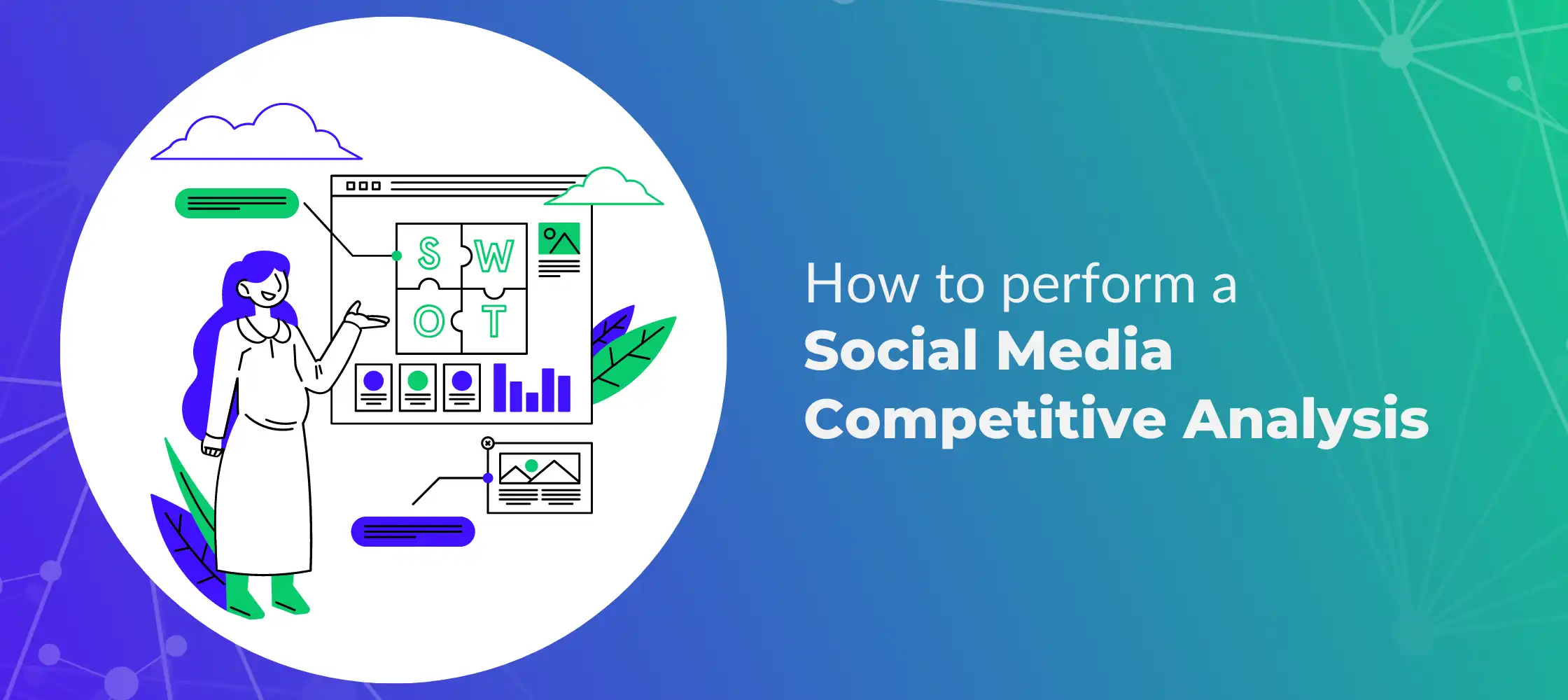Social media is a crucial part of any business growth strategy — businesses and brands can dispel brand information, build brand popularity, sell products, and gather data about customers and competitors within a day’s time, to say the least. In this article we’ll focus on competitor insights through social media, the steps to pull insights through a competitive analysis, and ways to bolster your strategy from there.
What is a Social Media Competitor Analysis?
A social media competitor analysis is the process of evaluating competitors on social media to find opportunities and build strategies. This tool helps identify competitors’ strengths and weaknesses to develop your own effective social media marketing strategy. Competitor analysis enables your business to learn information about your competitors’ target audience, as yours and your competitors’ audiences are most likely to overlap.
Benefits of Conducting a Social Media Competitive Analysis
Social media competitive analyses give brands insight into industry trends, audiences, and opportunities for improvement to stay ahead of the competition.
Gain insight into industry trends
Social media trends are key to building a strong social media strategy. With social media marketing analysis, your brand can identify niche opportunities that other competitors are taking advantage of. Your business can also gain insight into what social media marketing tactics work (and don’t work) for your competitors, such as new market trends and topics, what the audience already likes, and competitive keywords to help your brand rank.
Reach new audiences
Brands that take the time to learn from their competitors’ audience are able to gain insights to understand their own current and potential customers better. Consider the following questions to help you get to know these audiences and reach new ones.
- What are their interests?
- What social media platforms are they using?
- What type of content are they searching for?
- How do they consume content?
- When are they active on social media?
- What are they complaining about?
- What do they need solutions for?
Identify opportunities for improvement
Identifying areas of improvement and being open to change are key for brands seeking to grow in today’s climate. A SWOT analysis can help you identify what your business does best, as well as areas where you can improve.
- Strengths: what your business does well, such as qualities, resources, and assets.
- Weaknesses: what your business could improve on and what your competitors are better at.
- Opportunities: emerging needs for your products or services, underserved markets or areas.
- Threats: new competitors, negative reviews, and brand reputation problems.
Using SWOT you can assess your business’s current state and what areas you need to improve. With opportunities for improvement in mind, you will be able to set realistic goals to build a successful marketing strategy.
Stay ahead of the competition
The SWOT analysis can also be applied to your competitors to identify their own strengths and weaknesses. Their weaknesses can become your strengths if you use the insights wisely. It’s also important to look at where competitors may be ahead, so you can make improvements to those areas.
Steps to Conducting a Social Media Competitive Analysis
Businesses can benefit greatly from conducting a social media competitive analysis. Here is our 8-step guide to reap the benefits of this social media tool.
1) Identify competitors
Businesses that offer similar products or services as your brand have to solve the same problems as you do. That’s why it is important to find out who your direct and indirect competitors are. A quick way to do this is to identify competitive keywords, the keywords your brand uses that most likely overlap with competitors. Google keywords ranking search, and competitive research tools, are great ways to identify them.
2) Analyze social media presence
Your competitor’s social media presence offers useful insights and data to compare their performance to your own. Social media metrics such as account reach, impressions, followers, engagement rates, share of voice, organic traffic to page, and competitor keywords will help you get an idea of where your competitors are at comparatively.
3) Analyze social media content
Channel activities are a great source of information regarding your competitors’ social media content to see how active they are on social media and how they reply to comments and create engagement. This analysis will help you understand where the gaps are in their content strategy and engagement in comparison to your own.
What types of content do they post?
Take a look at their social media accounts to see the kind of content they usually post such as promotional, product-related, or user-generated content to see what is and isn’t working for them. Content format, form, and type will guide you on what could be working for your own social media platforms.
4) Analyze their audience
Your competitors’ audience is probably similar to yours. Your social media competitor analysis should include taking a look at their audience to learn about their interests, likes, age, location, and gender, to name a few.
What’s their brand persona?
Brand persona is key to understanding how your competitors present themselves to their customers on social media. Their brand voice, tone, and messaging point of view are all part of their brand persona. Brand persona analyses will give information on how they interact with customers online.
5) Identify their unique selling proposition
Businesses have their own strengths, which can be assets, resources, or simply things that they know how to do very well. These unique attributes are selling points that already work, and that you most likely will benefit from learning from.
6) Identify opportunities for improvement
Your competitors also have weaknesses. Take the time to see where they fall short on social media. Those gray areas are business opportunities for your brand to step in and implement better solutions.
7) Create an action plan
All the information and data you found while doing your competitor analysis will help in your own social media strategy. Creating an action plan will provide you with the outline and accountability for turning your insights into results.
Start by making a list of opportunities you want to implement from your analysis. Then put that list in priority order. Under each opportunity, list out specific action items needed to accomplish said goal, and assign each of those items to the proper team member with a proposed due date. As each opportunity is completed, you can check off and start monitoring or measuring performance.
8) Monitor and adjust.
Social media is an ever-evolving place. Your business must keep progress in check and continually monitor competitors as the competition continues to evolve and improve. Your social media strategy should include monthly, quarterly, midyear, and annual check-ins to identify new growth opportunities and help you stay on top of your competitors.
What Tools Can Aid You to Perform Social Platforms Analysis?
There are a few tools that can help you conduct your social media competitive analysis and help you keep the process as smooth and efficient as possible.
Social media monitoring tools
Social media listening tools are technologies that help track mentions of your brand or competitors. These tools can also report metrics related to engagement, impressions, reach, clicks, views, user sentiment, conversations, online mentions, and more.
Social media analytics tools
Social media analytics tools can help your business create performance reports to figure out what is working and what is not. Those tools are used to monitor and assess while providing historical data. Analytics tools are a great way to gather and find meaning in data from social media to help with data analysis and inform business decisions.
Social media scheduling tools
Social media scheduling tools assist social media post scheduling across all different platforms and accounts. These tools aid with identifying the best time to post to get maximum reach while optimizing marketing efforts.
Discover your Competition With ICUC
A social media competitive analysis enables brands to gain insight into new trends, reach new audiences, develop a strong brand identity, and stay ahead of the competition. Understanding your competitors, as well as your own strengths and weaknesses, is key to building an effective social media marketing strategy.
Need help starting your competitive analysis? Schedule a call with us here.

